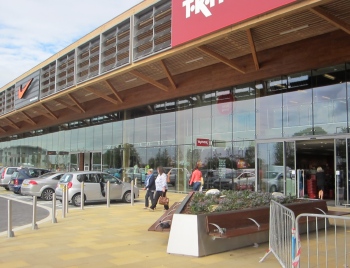Integrated solar PV systems

Integrating solar PV systems into the design of a building can deliver very elegant solutions, but they are far from common. Jonathan Bates of Photon Energy looks at the issues involved.
Most solar PV on buildings in the UK has been installed almost as an afterthought, either retrofitted to an existing building or installed to meet planning obligations. There are still relatively few examples of PV being used as an architectural feature or enhancement to a building, and therefore being designed in as an integrated part of a building.
This has partly been down to cost and partly because there is only a small number of companies in the UK with the engineering skills to design and install them. And this being despite the fact that the UK was once a world leader in building integrated PV, with the installation in 1993 of the 39.5 kW(p) PV façade at Northumbria University being the largest example of building-integrated photo-voltaics in the world at the time.
A fully integrated solar PV system is a far more complex installation than the more simple systems mounted on the roof of an existing building. These systems are predominantly, but not exclusively, installed in new-build applications where the solar panels are integrated into the building envelope.
 |
| Taplow Shopping centre integrates solar PV in 47 bays along the front of the shops. |
Inevitably, architects are involved in a big way, along with the builders, M&E services contractors, and specialist designers and installers of solar PV systems such as ourselves. Integrated systems can be expensive as they may require bespoke PV modules and purpose-designed fixing systems as well. The engineering skills required to design these systems are also a cut above what is necessary for a typical rooftop system because of the complexities of vertically mounted systems and, sometimes, confined working spaces.
As one of the few UK companies capable of this type of work, Photon Energy’s first installation of this type was back in 2010 in central London with the installation at Covent Garden NCP of 45 Romag all-black PV modules on two facades of an external stairwell. A further 21 dummy modules were installed on the lower, shaded part of the building.
Our most recent contract for the design and installation of an integrated system involves the installation of over 50 kW(p) of Upsolar PV modules. These are being vertically mounted as a plant screen wall on the east, west and south facades at Forbury Place in Reading, where the first of two buildings of approximately 17 200 m2 each is being built next to the railway station. Heavy-duty aluminium rails will be needed to span the 3.75 m between the fixing posts, and five Huawei inverters will convert the DC power generated into AC for the building’s distribution system.
Completed in 2014, the Bishop Centre retail park, Taplow, also in the Thames Valley, uses bespoke glass laminates on the front elevation to meet the architect’s brief for a stylish, high quality shopping centre. Here, the challenge was to install 188 Romag mono-crystalline glass laminates in 47 bays, constrained by tight tolerances and confined spaces, not to mention operatives working at a height of 8 m from a scissor lift platform.
The 120 kg frames for the louvre system were assembled on the ground and fitted with DC cables for the glass laminates before being lifted into position in a glulam fascia. The DC cables used to wire the louvres were installed behind the frames above the soffits of the timber canopy and connected once the soffits were installed, which also limited access.
Another factor that will come into play for all solar PV systems in the next couple of years is the impact of battery storage. As more and more PV systems are connected to the grid, the capacity of the grid to absorb all the power is becoming increasingly constrained. The current grid infrastructure was built for a one-way flow of electricity from power stations via transmission and distribution to end users; the grid was not designed for power to flow the other way, and this is where battery storage will have a vital role to play — in allowing energy to be stored when it is generated for use at a later time.
 |
| The building-integrated solar PV on the Covent Garden NCP car park comprises black modules on two facades of an external stairwell. |
At present, batteries are bulky and costly. Sizing them correctly for use within a building is very complicated — too much storage and the batteries will never fully charge (shortening their lifetime), too little storage and they will not have the capacity to store the energy from the PV. Spin-out from the electric-vehicle industry will inevitably result in far more compact products with lower prices to match, and experience in sizing will build as the number of installations increases.
Political, economic and technical factors will all affect whether more of these integrated systems are installed in the future. The Feed-in Tariff (FiT) will be reviewed this year, and there is talk of a specific rate for building-integrated solar PV systems, which could provide support for UK manufacturing and possibly help to ease prices downwards. Should this happen, the number of projects is likely to rise significantly.
Jonathan Bates is director and general manager of Photon Energy.







